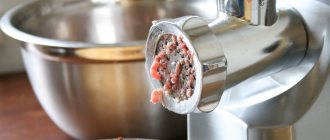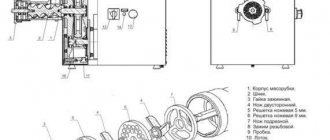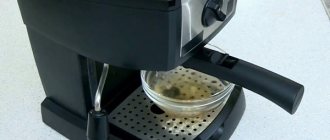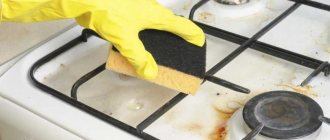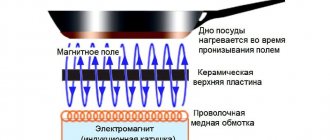In the kitchen there is a constant process of cooking. Even with the most careful handling, hot cookware will cause splashes of oil or pieces of food to fly off. It is simply impossible to keep equipment in the perfect condition it was when purchased, but maintaining cleanliness is within the power of every person. You just don’t need to delay the timely cleaning of equipment, but wash all functional surfaces immediately after cooking. If burnt food stains are allowed to harden, you will have to use aggressive household cleaning products to remove them. If handled incorrectly, they can damage the coatings, which will generally have a negative impact on the equipment. Therefore, it is best to immediately know how to wash the work surface where food was prepared using the right means.
General principles of care
The most correct option for caring for an electric stove is constant cleaning, which consists of regular wiping with a damp cloth after finishing cooking. But if you still cannot avoid the appearance of stains, and carbon deposits appear on the hob, then when the opportunity arises, you should start cleaning the device. Here it is important to know how to properly clean an electric stove without causing damage to it.
The principle of cleaning the electric stove and the preparations used depends on many factors:
- characteristics of the material;
- type of pollution;
- availability of additional components.
Recommendations for use and daily care
Before each cooking, check the stove for stains.
There are general rules of prevention:
- after cooking, the stove turns off and cools down;
- burnt marks (if any) are removed with a scraper;
- the surface is cleaned with dishwashing detergent;
- The stove is washed with clean water;
- The glass cleaner is applied and the surface is polished.
If there is no carbon deposits, after complete cooling the panel is wiped with a damp cloth. Targeted strikes should not be allowed.
If contaminants are ingrained, they soften before removal. The stove heats up slightly and water is poured onto the food. If household chemicals are used, they are distributed evenly and removed with a sponge after the period of time specified in the instructions. The panel is wiped with a damp cloth, then with a dry towel.
The biggest danger for glass ceramics is burning of plastic or sugar. These substances cause particularly persistent carbon deposits; they contribute to the formation of small cracks and holes. If jam or plastic gets on the panel during cooking, the stove must be turned off immediately, the stain removed, and washed. The same should be done if milk or coffee has “run away”.
What not to do
Before considering methods for cleaning the stove and the materials that will be used, you need to understand for yourself what is prohibited from doing when cleaning the stove.
- Some housewives mistakenly think that heating the burners will help speed up and make it easier to clean up burnt-on food debris. To some extent this is true, but with this option you can simply damage the coating. For example, it will crack or become scratched. Therefore, even during preventative cleaning, you must wait until it cools completely.
- Do not scrape burnt-on food with metal scrapers, brushes or knives.
- Do not allow plastic elements of cookware to come into contact with a hot burner: if the plastic melts, it is very difficult to get rid of the marks. Below we will talk about one of the ways to remove plastic.
- You should not use aluminum cookware, as when heated it leaves marks on the burners that in most cases cannot be removed. If there is a need to use such dishes, then you need to buy a disk as an adapter or a grid.
- The surface of the electric stove is very susceptible to the use of low-quality cookware. If it leaves scratches, you should completely abandon it.
It is easier to get rid of dirt, including carbon deposits, at the moment it appears. Here, you can use any cleaning gel or dishwashing liquid as a product. It is spread with a sponge onto the contaminated area, left for 5-10 minutes, then washed off with water. To prevent streaks from appearing, remove moisture with a dry cloth. It is worth noting that all these tips are also relevant for cleaning induction cookers.
Caring for a ceramic hob - what materials and tools should be used
The most important rule to know when looking for an answer to the question of how to clean a glass-ceramic stove is to avoid abrasive materials that can cause scratches on the surface. It is also not recommended to use strong household chemicals for cleaning, which may contain aggressive reagents and alkalis that lead to damage to the ceramics and the appearance of stains on it.
The procedure for cleaning the glass-ceramic surface itself can be presented in the form of two main stages:
- removal of old stains and heavy dirt by mechanical means;
- final cleansing using liquid products and soft sponges.
Glass ceramic hob scraper
How can you clean a glass-ceramic stove if burnt stains of fat, sugar or pieces of food appear? It will be difficult to do this with a simple rag. A special device comes to the rescue - a scraper. Structurally, this accessory consists of:
- a handle holder, which can be plastic or metal;
- blade, made in the form of a movable element or fixed;
- a screw used to replace the blade or fix it in position.
Important!
Scrapers made of plastic and having a fixed blade have a shorter service life than steel scrapers with moving elements.
It is advisable to purchase a scraper to clean a glass-ceramic hob in the following cases:
- there is a large amount of dried contaminants on the surface;
- it is necessary to quickly remove burnt food residues while the stove is still hot;
- Preventing scratches on the panel surface.
The procedure for using a scraper for cleaning glass ceramics is carried out according to the following scheme:
- You must first use a soft flannel cloth soaked in a special cleaner for glass-ceramic stoves to wipe the contaminated area.
- Wait some time until completely dry.
- Place the scraper at an angle of 30° to the surface and move back and forth.
- Upon completion, the stove is wiped again with a clean cloth.
For your information!
If you spend a lot of time or have to exert significant effort when cleaning with a scraper, then most likely the blades are dull and need to be replaced.
The cost of a scraper for cleaning glass ceramics will depend on the material and manufacturer. Plastic tools sell for no more than 100 rubles, but for high-quality metal accessories you will have to pay 300-500 rubles. Replacement blades cost about the same.
Napkins and sponges
The next important tool you can use to clean a ceramic hob is rags and sponges. One of the latest innovations is a special development that combines not only the cleaning accessory itself, but also the cleaning agent itself. We are talking about a melamine sponge.
The basis of this tool is melamine resin, which, after swelling, acquires a spongy state. Outwardly, such a sponge resembles a light block, no different from the usual piece of foam rubber that most housewives use. But appearances are deceiving. If we draw analogies in terms of cleaning power, we can say that the hardness of the material is similar to the strength of glass, and its abrasive properties are akin to sandpaper. The secret of efficiency lies in the special production technology of melamine foam.
Using a sponge is simple - just moisten it with water and clean it. At the same time, it is capable of removing even difficult stains. A prerequisite for this cleaning method is the subsequent removal of residual cleaning agent with water and wiping the panel dry with a towel.
Important!
One tip for using sponges is to avoid using dishwashing utensils. This is explained by the fact that when the cleaning agent reacts with residual grease on the sponge, a thin film is created on the working surface, which burns out when heated, and the panel loses its appearance.
How to Clean a Stainless Steel Stove
Of course, a stainless steel electric stove looks very beautiful and impressive, but the polished coating quickly becomes covered with streaks and various stains. The easiest way to remove fresh dirt is to apply any appropriate soap solution to it and leave it for a certain period of time. If the coating is thick and strong enough, then you need to remove the soap solution and stain only after half an hour. The metal reacts well to any drugs, even with the most caustic composition.
If the situation is hopeless and you can’t clean the stove with a simple sponge and detergent, then as an exception you can use a brush, a wire sponge and paste. But this should only be done in rare cases.
Comparison table of the best cleaning products for glass-ceramic panels
| Name | Main characteristics | Price |
| Selena-extra | It is able to cope with any dirt, does not irritate the skin of the hands, and helps remove even old grease stains. | ₽ 46 |
| Domax | Removes stains and simple stains, but cannot cope with already dried stains; it contains a large amount of silicone oil. | ₽ 275 |
| Dr. Beckman | Helps quickly deal with fresh stains and does not contain strong chemicals, so hand skin irritation is minimal. | ₽ 365 |
Additionally, you can find recommendations on how to wash a glass-ceramic stove, besides specially developed products. This includes glass and mirror cleaning liquids. They are used to improve the appearance and add shine to the panel.
How to clean a glass-ceramic hob with special products
The procedure for cleaning the glass-ceramic panel requires disconnecting the device from the power supply. This is important for two reasons:
- preventing short circuits due to liquid ingress;
- Reducing the risk of electric shock during cleaning.
The next step is to wait for it to cool completely. This warning is not only about preventing burns.
The general algorithm for cleaning glass ceramics is described by the following diagram:
- It is recommended to first moisten the surface with a soft cloth or sponge;
- to areas of more severe contamination or grease stains, it is necessary to apply a cleaning agent and wait for a certain time;
- Use a soft sponge to thoroughly wipe the surface of the stove;
- in areas of particularly heavy contamination, the cleaning procedure will need to be repeated;
- After this, the remaining cleaning agent should be completely removed from the frying panel with a damp cloth and finally wiped dry with a towel.
To clean stubborn stains from milk, sugar or other burnt foods, you need to apply a cleaning agent to the surface of the stain, leave it for about half an hour, and then use a scraper.
How to care for a glass ceramic hob
Glass ceramics is a modern high-tech, aesthetically attractive material with many advantages and one significant drawback. It is delicate, fragile, you need to use and care for it carefully, following certain rules. During operation, grease stains, carbon deposits, and smudges inevitably appear on the surface. Keeping the panel clean is important not only for its attractive appearance, but also for maintaining its technical qualities.
The glass-ceramic panel must be cleaned according to an algorithm.
- The stove must be disconnected from the power supply.
- You need to walk directly over the hot surface with a special scraper to remove carbon deposits.
- Using a soft sponge or cloth, apply a detergent solution to the surface, paying attention to contaminated areas.
- The detergent must be removed with clean water. Rinse off until all the product is removed.
- Next, you should use a special glass and mirror cleaner and use it to polish the panel to a shine.
Glass ceramic care
To keep glass ceramics clean, you need to have at home:
- special scraper for glass ceramics;
- a soft sponge without abrasive;
- a cloth (preferably microfiber);
- detergent (without abrasive components);
- dry rags for the final stage of cleaning.
Some slabs come with a special scraper. If not, it must be purchased separately. These scrapers have a thin metal blade. It copes well with fresh soot from sweets, dried food residues, and burnt milk.
Advice! To remove old stains, it is better to use a melamine sponge (“eraser sponge”). It needs to be moistened and the old stain rubbed. Afterwards, the surface must be washed according to the traditional algorithm.
Melamine sponge
What household chemicals are suitable for caring for glass ceramics?
Cleaning will be better and easier if you use special cleaning products. Gels, liquids and pastes are suitable for glass ceramics. It is important that the structure of household chemicals is gentle and homogeneous, without abrasive inclusions that can damage the surface . Among the products recommended for glass ceramics, it is worth paying attention to Silit Beng, Shumanit, Comet and Sanita. Users praise imported products that also do a good job of caring for panels: a branded product from the manufacturer Miele, as well as Domax, Heitmann and Toprens. This is a universal chemistry that perfectly removes stains of various types: plaque, soot, grease.
You should work with detergents in this order.
- Read the instructions, especially if there are “attention” blocks.
- You should wear gloves when working with chemicals, ensuring good ventilation in the room.
- Apply the product to the panel and use a soft sponge to rub the dirty areas.
- Clean the surface of any remaining product using a damp cloth, then wipe it dry.
Important! The detergent must be completely removed from the surface by wiping it repeatedly with a clean, damp cloth. Chemical residues during heating of the stove can damage it.
To tidy up the stove, giving it a mirror shine, you can use window and mirror cleaners. A slab polished with these solutions will look like new.
An easy way to remove stuck plastic from your cooktop
Not the most popular situation, but it still happens: a piece of plastic sticks to a heated glass-ceramic surface. It looks terrible, and removing the melted plastic is not so easy. This is how you can clean glass ceramics.
- Prepare baking soda, a dish sponge and distilled white vinegar (you can find it on the shelves under the Heinz brand).
- The hob must cool completely to room temperature.
- Plastic soot should be generously sprinkled with soda, then poured with vinegar and left for 0.5 minutes or more.
- Use a napkin to carefully remove the plastic (it will “go limp” and come off normally). It is important to do this without pressing, without rubbing, so as not to damage the glass-ceramic surface with a hard plastic piece.
- Use a clean cloth to remove any remaining dirt.
Cleaning the cast iron grate of a kitchen gas stove
The electric stove is washed with products that are sold in hardware stores and with the help of folk recipes.
In order to bring the surface to perfect condition, you will need:
- The product is gel-like or creamy.
- Dish detergent.
- Baking soda (not suitable for all types of stoves).
- Several sponges, a brush.
Having prepared all the equipment, you can begin. It is recommended to follow this sequence:
- Turn off the gas and electrical ignition power.
- The stove must cool completely after cooking. This will help avoid burns.
- Remove the grate, burners and handles that are soaked in soapy water.
- Remove food residues and crumbs with a dry sponge.
- If acidic chemicals are used for cleaning, be sure to wear gloves. Before using household chemicals, be sure to read the instructions.
Folk remedies
Cleaning the handles
It is much easier to wash handles, switches and other small-sized elements when they are removed. They are soaked in soapy water and then cleaned with a sponge. A toothbrush will help clean dirt in hard-to-reach places. At the end, each element is rinsed and dried.
If you don’t have time for thorough cleaning, you can get by with superficial cleaning. For this procedure, it is best to take anise drops with ammonia. A cotton pad is moistened in the solution, and the necessary elements are evenly processed. After five minutes, the solution is washed off with a damp cloth, even with old stains that are difficult to remove.
Special cases
Removing burnt stains on glass ceramics is not easy. This task is complicated by the fact that it is strictly forbidden to use cleaning powders, metallized sponges and other abrasive materials. They easily remove soot and dried food, but irreversibly damage the surface.
If it is impossible to remove stains from a hob at home the first time, then you should take a comprehensive approach, using both professional and folk methods.
Fat
To remove grease splashes on the hob:
- make a thick soap solution. Any dishwashing detergent or laundry soap will do.
- Apply foam to the hob using a sponge.
- After 7-10 minutes, wipe the plate.
- If oil stains remain, carefully remove the softened fat with a rubber scraper.
- First wash the surface with soap, then with clean water, and dry.
Vodka or alcohol on a cotton swab also works well to dissolve splashes of fresh oil and degrease surfaces. Remember that the tiles must be cold.
Nagar
If you do not clean the cooking surface from grease in a timely manner, soot accumulates, which is more difficult to deal with.
Method 1. Soda and lemon
To clean ceramic tiles:
- Wipe the surface with a regular detergent, remove any remaining product and light dirt.
- Apply a large paste of baking soda and lemon juice to heavily soiled areas.
- After 10 minutes, remove the soot with a scraper.
- Remove dirt with a microfiber cloth and wash the area with soap.
Method 2. Olive oil
Olive oil has good cleansing properties. Place a drop on a cotton pad and apply to the problem area. After half an hour, use a cloth, rinse the Fairy, rinse with clean water and wipe dry.
Toothpaste can also help. Apply carefully, without pressure, with a soft brush, taking care not to damage the glass ceramics.
Escaped milk, sugar, syrup
Boiled milk, spilled sugar or syrup should be removed from the stove immediately. Otherwise, the mass will thicken and it will be almost impossible to remove it.
How to remove stains:
- Turn off the power.
- Use a scraper to gently scrape up the sticky mixture before it hardens.
- Wash the damaged area with a soft sponge and soapy water.
- Once the surface has cooled, remove any remaining streaks and polish the surface with mirror spray or ammonia.
Important: Use a metal scraper. The plastic melts on a hot burner.
If the sugar has time to harden, but does not burn, boiling water will help. Pour some hot water onto the stain, wait a few minutes and then remove it with a sponge. Repeat the procedure several times until the sugar is completely dissolved.
Tea, coffee, cocoa
Toothpaste and baking soda or soda ash diluted with water will help remove traces of tea, cocoa or coffee.
Apply the contents, wait a few minutes and wipe with a soft cloth.
Using folk recipes
If for some reason you cannot wash the device with water and cleaning solutions, then you can use other means that you have at hand. Among the most effective means are the following.
- Baking soda. The substance should not be used in dry form, as it may cause scratches. The best way to cook pasta is using water. If the stain does not disappear, then add a little vinegar to the solution.
- Vegetable oil. A rather unusual method that will help clean any material, even from carbon deposits. The oil should be distributed throughout the stain and left for 30-40 minutes. After the specified time, use a rubber scraper to wipe off the dirt. Then the remaining traces of oil are removed.
Using the tips provided, you can easily get rid of dirt on the slab for a long time and maintain its original attractive appearance. It should be noted that housewives often have problems with cleaning the oven. Of course, you can also use folk remedies or household chemicals for this. Or you can simply buy a stove with a pyrolytic cleaning function. This method perfectly fights greasy deposits without the need to use any effort. In comparison with catalysis and hydrolysis methods, it is the most modern and convenient.
How to clean the grate
The primary issue for users of electric stoves is getting the grill in order. How to wash this structural element depends on the material of manufacture. The approaches to cleaning a cast iron sample and a stainless steel structure are significantly different.
Features of caring for cast iron grates
A grate made of cast iron can be cleaned by calcining it with a blowtorch. As a result of this thermal effect, the fat accumulated on the rods is burned. Next, you can apply a carbon cleaner to the part for a while, and then rinse the grate well and dry it with a towel.
Another way is to use a car engine cleaning solution. To do this, you need to thoroughly treat the grille with a cleaner, and then after a while, thoroughly rinse and dry.
Important! Both the blowtorch and the motor cleaner require special care when working to avoid injury from fire or caustic chemical solution.
Features of cleaning stainless steel grates
If a cast iron grate, due to the porosity of its material, is contraindicated for long-term soaking in detergent, then a part made of stainless steel can be kept in the solution for more than 2 hours . If there is heavy dirt, you can soak it overnight so that the dirt is properly softened and can be easily wiped off with a rag.
Cleaning ovens on electric stoves
Here the cleanliness of the door immediately catches your eye. As a rule, it is characterized by a folding design and is mounted on hinges. If the cleaning is thorough, feel free to remove the door . Anyone can do this: there are special latches on the hinges that must be turned, the door lifted and pulled out towards you. However, the reverse installation can be much more problematic. If you are not confident in your abilities, clean the item on the spot.
Some door models, which are often found in the Siemens and Bosch brands, move forward, becoming additional support for baking trays and grates. They can also be dismantled, but at the end you will be left with a bulky corner structure, which is not so convenient to wash in the sink. So here too it’s better to put everything as it is.
Speaking directly about cleaning, brown deposits from the door and inner walls can be easily removed with wet soda or specialized sprays for Schumanite ovens. All surfaces are treated and wiped dry.
Pay attention to the glass
The flawless glass of the oven door testifies to the accuracy and diligence of the owner or housewife. Meanwhile, this is a rather fragile place. In most stoves, the inner glass can be removed. This makes it much more convenient to clean between the glass, where smudges are common . Dismantling is not troublesome - just unscrew the fastening bolts with a suitable screwdriver.
The easiest doors to clean are those that are completely covered with glass on the inside. Here you can use glass cleaners and ammonia. Any product is applied by spraying, wiped with a soft cloth and polished with microfiber.
Internal surfaces of the chamber
Cleaning the oven is a troublesome process, but all manipulations can be kept to a minimum using easy cleaning techniques.
The simplest thing is to park
If the chamber dirt is persistent, you can first soften it by running hydrolysis cleaning . This method is available in almost all models of electric stoves. Hydrolysis works using hot steam. To do this, pour about half a liter of water into a baking tray and start the mode at a temperature of 50 degrees. This is necessary so that the water does not evaporate in one moment, and the hot steam has time to soften the dirt. After half an hour, the soft coating is removed with a sponge or napkin. Models with automatic cleaning do not have this headache either.
I note that in electric stoves, where hydrolysis cleaning is provided, the walls are made of smooth enamel. They do not absorb plaque and dirt does not stick tightly. The swollen carbon deposits are really removed in one motion. The instructions must indicate the possibility of such exposure (temperature and duration of the procedure).
Catalysis for the lazy
Catalysis was invented for those who don't want to bother with oven cleaning at all . All salt is contained in special catalytic panels. Their number in the oven varies from 1 to 3 (one back, two side). The enamel in them is porous and it is in the pores that oxidation of fat and food debris occurs. Against the background of temperature exposure, they burn, forming a thin ash layer. After preparing the dish, simply wipe it off with a damp cloth.
However, such modern technology is not without its drawbacks. Catalytic panels lose their properties over time and require periodic replacement, on average every 3-5 years . If you do not change the inner walls in time, they will begin to become overgrown with a layer of dirt, like in a simple oven. In addition, you still have to wash the bottom and doors yourself. Please note that the other side of the panels also has catalytic properties; complete replacement can be delayed by simply turning them inside out.
High temperatures will burn everything out
Heating up to a temperature of 500 degrees, the oven burns out all contaminants . This is exactly how pyrolysis works - the most expensive cleaning method. These plates are the most reliable, otherwise they would not withstand such temperature pressure. The security system, the materials used - everything is thought out to the smallest detail.
The process is launched by a special program. In this way, you can clean not only the internal walls, but also baking trays and racks. However, maximum efficiency is achieved in a completely empty oven . Apart from energy costs, the method does not have any disadvantages.
Features of cleaning handles, baking trays and grids
Rotary controls and other small parts can be easily cleaned when they are removed from the instrument. The easiest way is to soak them in a soapy solution, additionally treating them with a soft sponge. If the plaque is in a hard-to-reach place, it can be easily removed with an old toothbrush. Before reinstalling the handles, dry them thoroughly.
Stainless steel grates and baking trays can be cleaned as follows:
- heavily soiled items are soaked in a vinegar-soda solution for several hours. After soaking, dirt can be easily removed with a brush and rinsed with clean water;
- The dried fat is rubbed with soda, left for half an hour and rinsed.
Attention to details
There are a lot of electric stoves on sale that lack automatic capabilities. Smart enamel for easy cleaning and other options can be an advantage here . Please note that on the side walls of the chamber there are holders for baking sheets, grates, and there may be removable guides. All this also requires attention and cleaning with special products or soap solutions.
There is a lamp in the chamber; it is better to remove it and wash it under the tap or in the dishwasher. Convection cookers have fans and heaters. It is better to protect these things with a grease filter . This simple step will help avoid time-consuming cleaning. The mesh filter is easy to secure with brackets or latches and is easy to wash in the dishwasher.
Oven ceiling
Tens can be fixed on the ceiling of the chamber. Essentially, these are thin, curved tubes. Sometimes this is where lighting is provided. This is not easy to clean. Firstly, pressure is unacceptable, as you could damage something important. To avoid difficulties, it is better to initially choose a model with a folding heating element. It is removable and the ceiling is completely accessible for cleaning . Otherwise, you will have to dodge and clean out the carbon deposits between the additional heating elements.
Special household chemicals - how to choose
To wash electric stoves, all the achievements of the chemical industry are used, from powders to gels.
Products for ovens, microwaves, grills
This is, so to speak, heavy artillery. Products with the maximum number of active ingredients are available in several forms. These can be sprays, aerosols, etc. When applied to the surface, protein and fat begin to break down. All that remains is to collect the dirt with a napkin. However, they cannot be used on models with an automatic cleaning function and on glass ceramics.
Powders: all the pros and cons
All powders are abrasive and therefore are not used on enamel and glass-ceramic surfaces . Such products can be carefully used on stainless steel, but not all manufacturers allow this. First, you should clean a small area; if there are no scratches or other damage on it, you can safely move on to cleaning the rest.
Creamy and gel-like products
Such drugs leave virtually no mechanical damage. The composition includes microgranules, which take on the function of the active component. The gel or cream is applied to the moistened surface and left for a few minutes, after which it is rinsed with water.
This is the optimal solution for restoring the purity of enamel, ceramics, and glass. The products are used in conjunction with soft cloth napkins and sponges.
Foams and pastes
These are more concentrated products that provide high cleaning efficiency; in addition, they are always economical. The pastes have a dense texture, which makes cleaning vertical surfaces easier.
Dishwashing liquid
All surfaces of the electric stove can be cleaned using such products. They break down fats well and are easily washed off. The soft gel will never damage enamel, glass or stainless steel.
Protection and silicone
Products containing silicone are used to protect glass-ceramic surfaces . There really is a reason for this. After the hob is perfectly clean, the preparation is applied and rubbed with a napkin. As a result, a thin protective layer is formed. Grease and plaque do not linger and you will have to wash the equipment much less often. Silicone may initially be included in cleaning products.




